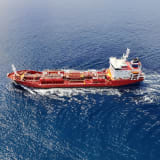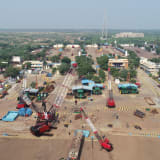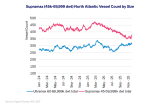
Market eyes further LNG price upside as summer nears
A recent uptick in LNG prices following months of generally subdued activity and suppressed levels has fuelled questions among market participants about whether such gains will be sustained, particularly as the northern hemisphere summer – when LNG consumption typically rises – nears.
LNG prices have been characterised by weakness for most of this year. While they have on occasion shown signs of strengthening, generally tepid demand and ample supply availability have put a cap on those gains, tamping prices down and keeping them below the psychological threshold of $10/MMBtu.
But a recent double whammy of supply disruptions and demand emergence has pushed prices beyond that threshold, piquing the interest of buyers and sellers alike and sparking questions on the extent of the upside as the June-August summer season approaches.
The front-month price of the Platts Japan/Korea Marker (JKM) – a benchmark price assessment for spot physical LNG deliveries to Northeast Asia – was last assessed at $12.407/MMBtu on 31 May, up by 24% from $9.992/MMBtu on 1 May.
While prices have hardly scaled to peaks reached in the wake of the Russia-Ukraine war in February 2022, the recent levels represent a rejuvenation of the market following a prolonged period of prices languishing in the high $7s/MMBtu to high $9s/MMBtu range from January to April.
The JKM front-month price averaged $9.498/MMBtu from 1 January to 30 April this year, compared to $15.631/MMBtu in the same period last year. A surge in demand for the fuel – both in Europe and Asia – on the back of a curtailment in Russian gas flows amid the war had pushed the benchmark price to an all-time high of $84.762/MMBtu on 7 March 2022, nearly 50 times the record low of $1.825/MMBtu on 28 April 2020 as the Covid-19 outbreak slashed global demand for the fuel.
Asian end-users re-enter market
Recently renewed interest among some Asian end-users to procure cargoes following a period of hiatus has injected life to a market that was for a while this year dominated by buying activity from trading firms and portfolio players. Mild weather, stable supply of contractual volumes, as well as healthy output from alternative fuels had kept LNG inventories at healthy or high levels, crimping spot demand for the fuel among end-users.
But hotter weather in May in some countries such as Japan has coincided with lower output of alternative fuels such as hydro and coal due to lower rainfall and coal-fired plant outages respectively, pushing some of the country’s utilities to purchase spot LNG cargoes, mainly for deliveries in June and July, to meet power needs.
Several buyers in India including Gujarat State Petroleum (GSPC), GAIL and IOC have also emerged to buy spot cargoes for June and July deliveries for uses in the fertiliser, refinery and power sectors. And countries such as Thailand have remained regular spot buyers especially amid sweltering weather.
However, major buyers in South Korea, China and Japan have remained noticeably absent from the spot market, mostly due to ample inventories.
Supply glitches reduce cargo availability
Besides recent transactions absorbing some of the available spot supply, outages at various liquefaction projects in Malaysia, Australia, Brunei and the US had also reduced output and shrunk the spot supply pool, contributing to the climb in prices.
The 29.3mtpa Bintulu LNG export project in Malaysia was plagued with various production issues in the last few weeks, pushing plant owner and operator – Malaysian state-owned PETRONAS – to reach out to term buyers requesting to defer deliveries, mainly from May to July onwards, SSY understands.
The Bintulu project was shut on 10 May due to a power loss, PETRONAS said on 14 May, adding to what SSY understood to be upstream issues that had occurred at its new gas fields in early May. And while PETRONAS said on 23 May that the project had successfully resumed full operations on 19 May, it is uncertain what rate the project is currently producing at, with some market participants suggesting that output from the plant continues to be curtailed.
Meanwhile, the 5.2mtpa Train 2 of Chevron’s three-train 15.6mtpa Gorgon LNG project in Australia was shut from 30 April to 28 May due to a fault in a turbine. And the 15mtpa Freeport LNG project in Texas was operating only at partial capacity from January to May this year, first due to a damage that occurred in one of the motors of the 5mtpa Train 3 because of freezing weather in January that had kept it offline until March, and later due to inspection of the other two similar-sized trains from March to May. The 7.2mtpa Brunei LNG project in Lumut also experienced a compressor failure on 20 May that likely cut output from the plant for about a week, market participants told SSY.
Weather to be key in determining summer demand
Temperatures during the summer months will be a key factor determining the strength of LNG demand. High temperatures will drive cooling needs, potentially drawing down LNG inventories and fuelling restocking requirements. Major Northeast Asian buyers have in past years entered the market to seek strips of summer cargoes in anticipation of hot weather and ended up snapping up substantial volumes from the market.
Japan’s main utilities held 2.06mn t of LNG in their inventories as of 26 May, down by around 9% from 2.26mn t the previous week following a 7% rise from the previous week of 2.12mn t, according to the country’s Ministry of Economy, Trade and Industry (METI). The latest figures are down from the 2.41mn t recorded at the end of last May and the end-May average of 2.11mn t from 2019-23.
Current weather forecasts are predicting a hotter-than-usual summer in Northeast Asia this year. The Japan Meteorological Agency is predicting the probability of above-normal temperatures to be 50% in Hokkaido and Tohoku, 60% in Hokuriku, Kinki, Kanto Koshin, Chugoku, Shikoku and Kyushu, and 70% in Amami and Okinawa, according to its forecast published on 21 May.
The Korea Meteorological Administration is forecasting a 50% chance of above-normal temperatures in June and August throughout the country, versus a 20% chance of below-normal and 30% chance of normal temperatures in those months, according to its forecast published on 23 May. It is also predicting a 40% chance each of normal and above-normal temperatures in July, versus a 20% chance of below-normal temperatures in the month.
By Joey Chua, Market and Data Analyst, LNG, SSY
Articles
You may also be
interested in
View allGet in touch
Contact us today to find out how our expert team can support your business














